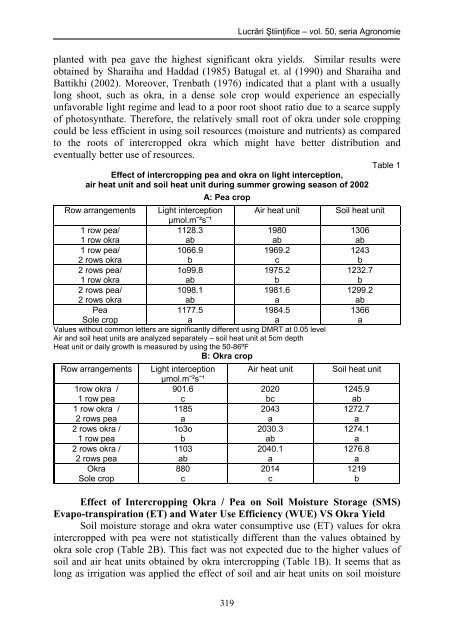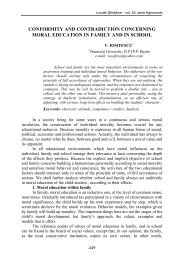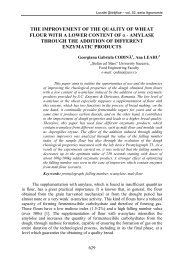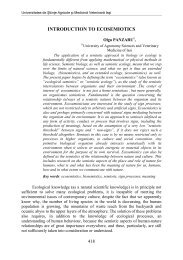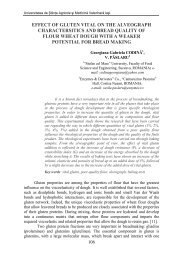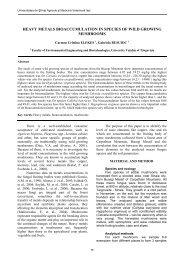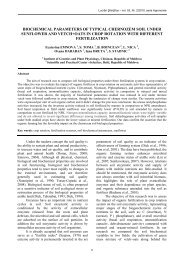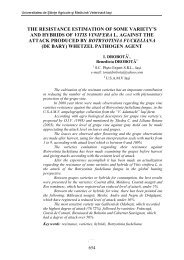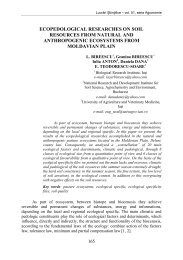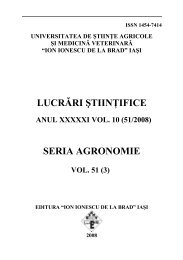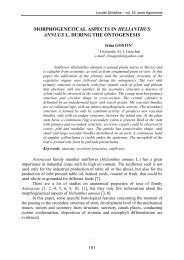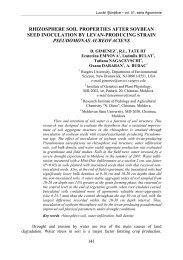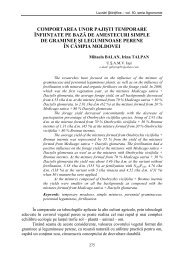environmental impact on yield of pea and okra grown under ...
environmental impact on yield of pea and okra grown under ...
environmental impact on yield of pea and okra grown under ...
Create successful ePaper yourself
Turn your PDF publications into a flip-book with our unique Google optimized e-Paper software.
Lucrări Ştiinţifice – vol. 50, seria Agr<strong>on</strong>omie<br />
planted with <strong>pea</strong> gave the highest significant <strong>okra</strong> <strong>yield</strong>s. Similar results were<br />
obtained by Sharaiha <strong>and</strong> Haddad (1985) Batugal et. al (1990) <strong>and</strong> Sharaiha <strong>and</strong><br />
Battikhi (2002). Moreover, Trenbath (1976) indicated that a plant with a usually<br />
l<strong>on</strong>g shoot, such as <strong>okra</strong>, in a dense sole crop would experience an especially<br />
unfavorable light regime <strong>and</strong> lead to a poor root shoot ratio due to a scarce supply<br />
<strong>of</strong> photosynthate. Therefore, the relatively small root <strong>of</strong> <strong>okra</strong> <strong>under</strong> sole cropping<br />
could be less efficient in using soil resources (moisture <strong>and</strong> nutrients) as compared<br />
to the roots <strong>of</strong> intercropped <strong>okra</strong> which might have better distributi<strong>on</strong> <strong>and</strong><br />
eventually better use <strong>of</strong> resources.<br />
Table 1<br />
Effect <strong>of</strong> intercropping <strong>pea</strong> <strong>and</strong> <strong>okra</strong> <strong>on</strong> light intercepti<strong>on</strong>,<br />
air heat unit <strong>and</strong> soil heat unit during summer growing seas<strong>on</strong> <strong>of</strong> 2002<br />
A: Pea crop<br />
Row arrangements Light intercepti<strong>on</strong> Air heat unit Soil heat unit<br />
µmol.m¯²s¯¹<br />
1 row <strong>pea</strong>/<br />
1 row <strong>okra</strong><br />
1128.3<br />
ab<br />
1980<br />
ab<br />
1306<br />
ab<br />
1 row <strong>pea</strong>/<br />
2 rows <strong>okra</strong><br />
1066.9<br />
b<br />
1969.2<br />
c<br />
1243<br />
b<br />
2 rows <strong>pea</strong>/<br />
1 row <strong>okra</strong><br />
1o99.8<br />
ab<br />
1975.2<br />
b<br />
1232.7<br />
b<br />
2 rows <strong>pea</strong>/<br />
1098.1<br />
1981.6<br />
1299.2<br />
2 rows <strong>okra</strong><br />
ab<br />
a<br />
Pea<br />
1177.5<br />
1984.5<br />
Sole crop<br />
a<br />
a<br />
Values without comm<strong>on</strong> letters are significantly different using DMRT at 0.05 level<br />
Air <strong>and</strong> soil heat units are analyzed separately – soil heat unit at 5cm depth<br />
Heat unit or daily growth is measured by using the 50-86ºF<br />
B: Okra crop<br />
Row arrangements<br />
1row <strong>okra</strong> /<br />
1 row <strong>pea</strong><br />
1 row <strong>okra</strong> /<br />
2 rows <strong>pea</strong><br />
2 rows <strong>okra</strong> /<br />
1 row <strong>pea</strong><br />
2 rows <strong>okra</strong> /<br />
2 rows <strong>pea</strong><br />
Okra<br />
Sole crop<br />
Light intercepti<strong>on</strong><br />
µmol.m¯²s¯¹<br />
901.6<br />
c<br />
1185<br />
a<br />
1o3o<br />
b<br />
1103<br />
ab<br />
880<br />
c<br />
Air heat unit<br />
2020<br />
bc<br />
2043<br />
a<br />
2030.3<br />
ab<br />
2040.1<br />
a<br />
2014<br />
c<br />
ab<br />
1366<br />
a<br />
Soil heat unit<br />
1245.9<br />
ab<br />
1272.7<br />
a<br />
1274.1<br />
a<br />
1276.8<br />
a<br />
1219<br />
b<br />
Effect <strong>of</strong> Intercropping Okra / Pea <strong>on</strong> Soil Moisture Storage (SMS)<br />
Evapo-transpirati<strong>on</strong> (ET) <strong>and</strong> Water Use Efficiency (WUE) VS Okra Yield<br />
Soil moisture storage <strong>and</strong> <strong>okra</strong> water c<strong>on</strong>sumptive use (ET) values for <strong>okra</strong><br />
intercropped with <strong>pea</strong> were not statistically different than the values obtained by<br />
<strong>okra</strong> sole crop (Table 2B). This fact was not expected due to the higher values <strong>of</strong><br />
soil <strong>and</strong> air heat units obtained by <strong>okra</strong> intercropping (Table 1B). It seems that as<br />
l<strong>on</strong>g as irrigati<strong>on</strong> was applied the effect <strong>of</strong> soil <strong>and</strong> air heat units <strong>on</strong> soil moisture<br />
319


